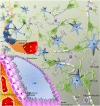Transport and metabolism at blood-brain interfaces and in neural cells: relevance to bilirubin-induced encephalopathy
- PMID: 22629246
- PMCID: PMC3355510
- DOI: 10.3389/fphar.2012.00089
Transport and metabolism at blood-brain interfaces and in neural cells: relevance to bilirubin-induced encephalopathy
Abstract
Bilirubin, the end-product of heme catabolism, circulates in non-pathological plasma mostly as a protein-bound species. When bilirubin concentration builds up, the free fraction of the molecule increases. Unbound bilirubin then diffuses across blood-brain interfaces (BBIs) into the brain, where it accumulates and exerts neurotoxic effects. In this classical view of bilirubin neurotoxicity, BBIs act merely as structural barriers impeding the penetration of the pigment-bound carrier protein, and neural cells are considered as passive targets of its toxicity. Yet, the role of BBIs in the occurrence of bilirubin encephalopathy appears more complex than being simple barriers to the diffusion of bilirubin, and neural cells such as astrocytes and neurons can play an active role in controlling the balance between the neuroprotective and neurotoxic effects of bilirubin. This article reviews the emerging in vivo and in vitro data showing that transport and metabolic detoxification mechanisms at the blood-brain and blood-cerebrospinal fluid barriers may modulate bilirubin flux across both cellular interfaces, and that these protective functions can be affected in chronic unconjugated hyperbilirubinemia. Then the in vivo and in vitro arguments in favor of the physiological antioxidant function of intracerebral bilirubin are presented, as well as the potential role of transporters such as ABCC1 and metabolizing enzymes such as cytochromes P-450 in setting the cerebral cell- and structure-specific toxicity of bilirubin following hyperbilirubinemia. The relevance of these data to the pathophysiology of bilirubin-induced neurological diseases is discussed.
Keywords: ABC transporters; OATP; UDP-glucuronosyltransferase; astrocyte; biliverdin; blood–brain barrier; choroid plexus; glutathione-S-transferase.
Figures

Similar articles
-
Blood-brain interfaces and bilirubin-induced neurological diseases.Curr Pharm Des. 2009;15(25):2893-907. doi: 10.2174/138161209789058147. Curr Pharm Des. 2009. PMID: 19754366 Review.
-
New concepts in bilirubin encephalopathy.Eur J Clin Invest. 2003 Nov;33(11):988-97. doi: 10.1046/j.1365-2362.2003.01261.x. Eur J Clin Invest. 2003. PMID: 14636303 Review.
-
Modulation of bilirubin neurotoxicity by the Abcb1 transporter in the Ugt1-/- lethal mouse model of neonatal hyperbilirubinemia.Hum Mol Genet. 2017 Jan 1;26(1):145-157. doi: 10.1093/hmg/ddw375. Hum Mol Genet. 2017. PMID: 28025333
-
Molecular basis of bilirubin-induced neurotoxicity.Trends Mol Med. 2004 Feb;10(2):65-70. doi: 10.1016/j.molmed.2003.12.003. Trends Mol Med. 2004. PMID: 15102359 Review.
-
Bilirubin chemistry and metabolism; harmful and protective aspects.Curr Pharm Des. 2009;15(25):2869-83. doi: 10.2174/138161209789058237. Curr Pharm Des. 2009. PMID: 19754364 Review.
Cited by
-
Novel Biochemical Insights in the Cerebrospinal Fluid of Patients with Neurosyphilis Based on a Metabonomics Study.J Mol Neurosci. 2019 Sep;69(1):39-48. doi: 10.1007/s12031-019-01320-0. Epub 2019 Jul 18. J Mol Neurosci. 2019. PMID: 31321646
-
The role of bile pigments in health and disease: effects on cell signaling, cytotoxicity, and cytoprotection.Front Pharmacol. 2012 Jul 13;3:136. doi: 10.3389/fphar.2012.00136. eCollection 2012. Front Pharmacol. 2012. PMID: 22811668 Free PMC article. No abstract available.
-
Vascular network expansion, integrity of blood-brain interfaces, and cerebrospinal fluid cytokine concentration during postnatal development in the normal and jaundiced rat.Fluids Barriers CNS. 2022 Jun 7;19(1):47. doi: 10.1186/s12987-022-00332-0. Fluids Barriers CNS. 2022. PMID: 35672829 Free PMC article.
-
Bilirubin: a game-changer in alzheimer's therapy? Unveiling its neuroprotective and disease-modifying potential.Metab Brain Dis. 2025 Jun 16;40(6):224. doi: 10.1007/s11011-025-01653-3. Metab Brain Dis. 2025. PMID: 40522412 Review.
-
Bilirubin Triggers Calcium Elevations and Dysregulates Giant Depolarizing Potentials During Rat Hippocampus Maturation.Cells. 2025 Jan 23;14(3):172. doi: 10.3390/cells14030172. Cells. 2025. PMID: 39936964 Free PMC article.
References
-
- Beiswanger C. M., Diegmann M. H., Novak R. F., Philbert M. A., Graessle T. L., Reuhl K. R., Lowndes H. E. (1995). Developmental changes in the cellular distribution of glutathione and glutathione S-transferases in the murine nervous system. Neurotoxicology 16, 425–440 - PubMed
LinkOut - more resources
Full Text Sources

